|
Pininfarina
|
1930 - Present |
Country: |
 |
|
Battista Farina
The Societa Anonima Carrozzeria Pinin Farina was established in Turin on the 22nd of May, 1930. It was promoted from the start by Battista Farina (known as Pinin). Battista, already famous as the grand master of coachbuilding, had spent years designing splendidly styled cars in his brother's factory. Among men who influenced the still-young Pinin to set up a coachbuilding shop of his own was Vincenzo Lancia, a great friend and admirer, who supported the Societa together with Giavanni Battista Devalle, Gaspare Bona, Pietro Monateri and Arrigo De Angeli, all admirers of Farina's work.
In Pinin's modern and well equipped establishment, the wheels started turning straight away with a great deal of phrenetic activity. With Pinin's expertise and enthusiasm, this activity soon led to the creation of an individual elegant and classic style, known almost universally as the 'Italian line'. In August of 1930, just two months after the company had been set up, a superb spyder-cabriolet, based on the Lancia Dilambda, was delivered to the Queen of Romania. Work also started on a car for the King of Iraq and a Hispano-Suiza special for the Sheik of Heggiaz.
In October, Pinin Farina exhibited some of his creations at the Paris Show; they were all a great success, especially a sports-cabriolet based on a Lancia Dilambda chassis. This was a beautifully proportioned car, characterised by a deep windscreen and a sharply cut-off rear. This car did not show great signs of originality: its beauty lay, nearly exclusively, in the style and refinement of each small part. This car revealed an unmistakable design style with a great harmony between the components.
At the beginning of the 1930s the best exhibitions for the coachbuilders to show their creations were the concours d'etegance. The first of these in which Pinin Farina took part was in Monte Carlo on 22 March 1931, he came first in his category, with a Mercedes and a Hispano-Suiza. After taking first prizes at Milan and Rome, he won the Gold Cup of Villa d'Este, in September of the same year, with a Lancia Dilambda belonging to Rudolph of Drago.
The customers for his coachbuilding works flowed thick and fast: by 1932, Pinin Farina was already well known for his stylistic creations around the world. In that year, he produced a cabriolet based on the chassis of the Alfa Romeo SC 2300. This had a really elegant line, enhanced by joining the front wings, the rear wings and the running boards in one flowing shape. The fast and light car was just right for the sporting image of the time. The cabriolet 2300 had a slightly inclined windscreen; this was continued in two Fiat Ardita models, a 2000 and a2500. These cars won first and second places in the concours at Cannes in 1934. The inclined screen, which stopped glare, offered less wind resistance and gave a better view, and it constituted a significant innovation and a major change in the old-fashioned coachbuilding school of thought.
Although he had no formal training in aerodynamic theory (unlike Jaray, who had conducted a deep study into the matter), Pinin Farina developed the rounded type of styling, which to him seemed bound to come. He developed this idea with his Lancia Aprilia of 1936; in this futuristic model he used a curved windscreen and a body of wood and metal mounted on a steel frame. Although interest was aroused, the aerodynamic Aprilia faced a great deal of criticism from the public, whose traditional opinions inevitably clashed with the style of this unusual car. When Pinin Farina presented his second version of this car in 1937, it was less futuristic, but still very original, and with it he advanced a great deal. Through a good deal of study, Pininfarina's design for the new car was based on the concepts of aircraft design. This was to prove highly successful as the car was to reach speeds of up to 160 kph during the
Mille Miglia of 1935.
Curved and Raked Windscreens
Farina continued to develop his ideas and several of his designs prior to World War 2 featured items like streamlined bonnets and mud guards and curved, steeply raked windscreens. Some of his better known creations around this period included a four-door cabriolet on a Lancia Asturia chassis, which won the 1937 San Remo event, the special cabriolet
Alfa Romeo 8C 2900, a Fiat 1500 coupe and a Lancia Aprilia sedan of 1940. World War 2 put a stop to the developing Italian motor industry which then turned its attention to the manufacture of military vehicles, ambulances and various other items necessary to the war effort. In October 1946, the Italians began exporting cars again and included in the original batch were two Pinin Farina creations, an Alfa Romeo Sport 2500 and a specialist design on the Lancia Aprilia chassis.
By now, however, the centre of car-fashion designing had swung to Paris, and Pinin Farina decided to show his creations in the French capital. It proved to be a shrewd move and, before long, he began to make his mark. In 1947, Pinin Farina captured the imagination of the motoring world with his Cisitalia sports coupe. By this time, Pinin Farina had realised that cars should be more than just attractive and he began to concentrate his studies on the aspects of comfort, visibility, performance and practicality. The Cisitalia was a splendid example of his theories: it was a simple, uncluttered design and was finished to a remarkably high standard of precision. Some sixty of these Cisitalias were produced before a new two-seater was introduced. This in turn gave way to a 2+2 design.
The 2 + 2 configuration was not one of Pinin Farina's favorite styles - he argued that 2+2 seldom added up to four and was more like three. Nevertheless, the car was full of interesting innovations. The boot was a lot lower than the mud guards, completely in contrast to most cars of that period. The dimensions of the doors, too, were also reduced to a minimum. Little chrome was used, and all-round visibility was made a top priority. The seats were also extremely comfortable for a car of its size. Consequently, the car attracted a lot of attention and further enhanced Farina's growing reputation. By now, Pinin Farina's Turin workshops had been renovated and the factory was used to produce
Cisitalias, a Maserati two-seater and the low and sleek four-seater Alfa Romeo of 1949. Also worthy of mention was a two-seater coupe using Fiat mechanicals and a beautiful cabriolet Alfa Romeo built in 1950.
The Lancia B24 America
A year later, Farina produced the Lancia Aurelia B20. With this car he continued many of the concepts he had established with his work on the Cisitalia cars. The Aurelia B20 was a sleek grand tourer and the car was a superb example of power and elegance. It was quiet, yet quick, and extremely well made. It proved so popular that the model remained in production for another six years. In 1954, Farina developed an open version of the Aurelia. This was the Spyder, which was also known as the B24 America. This car was soon regarded as one of the best examples of a sports tourer ever built. The beauty of this model, the harmony of its proportions and the elegance of its form established it as a classic and, once again, Farina was hailed as a genius of automotive styling.
Many of the styling principles developed on the Spyder were used on the Alfa Romeo Giulietta Spyder, introduced a few years later, and the value of many of Farina's ideas was confirmed by the fact that the little Alfa Spyder stayed in production until 1967. Apart from the Lancia Aurelia Spyder, PininFarina produced a number of other interesting designs during the early 1950s. These. included a Ferrari Berlinetta 375M and the Ferrari Spyder Mondial 500 plus various Alfa 2500s and 1900 coupes and cabriolets. It was during this period that Farina began attracting attention from manufacturers here in the USA. Years before (1931) he had done some work for
Cadillac, but now he was commissioned firstly by
Nash and then by
American Motors to produce designs for them.
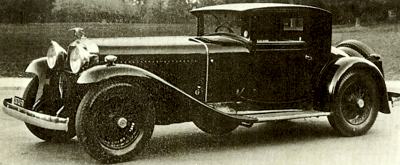 Pinin Farina designed 1932 Hispaon-Suiza coupe.
Pinin Farina designed 1932 Hispaon-Suiza coupe.
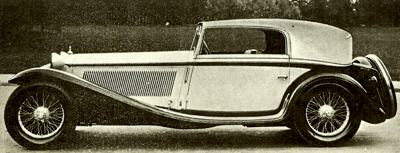 Pinin Farina designed 1932 Alfa Romeo 8C 2300.
Pinin Farina designed 1932 Alfa Romeo 8C 2300.
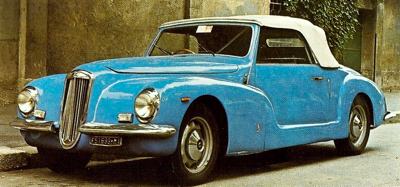 Pinin Farina designed 1946 Lancia Aprilia.
Pinin Farina designed 1946 Lancia Aprilia.
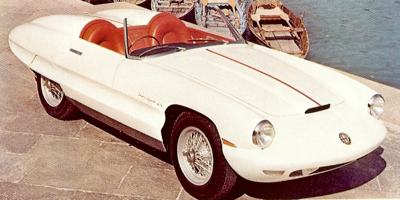
Pinin Farina designed 1958 Alfa Romeo 3500 Spyder.
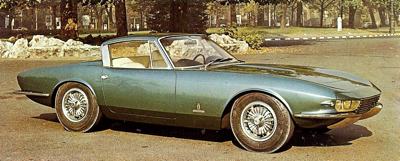 Pinin Farina designed Rondine based on a Chev Corvette chassis.
Pinin Farina designed Rondine based on a Chev Corvette chassis.
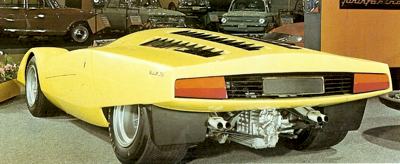 Pinin Farina designed 1969 Ferrari 512.
Pinin Farina designed 1969 Ferrari 512.
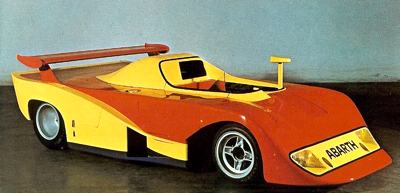 1974 Pininfarina Abarth 2000.
1974 Pininfarina Abarth 2000.
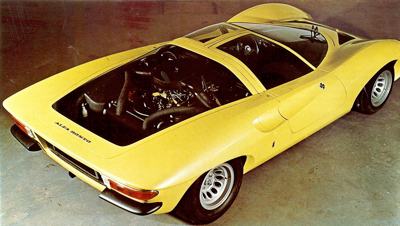 1969 Pininfarina Alfa Romeo 33 Racer.
1969 Pininfarina Alfa Romeo 33 Racer.
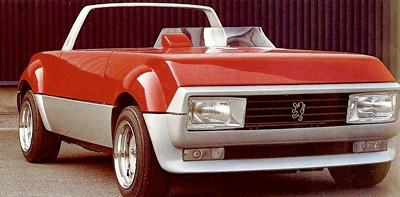 The less successful Peugette, Pininfarina's sports car project based on a Peugeot 104 ZS.
The less successful Peugette, Pininfarina's sports car project based on a Peugeot 104 ZS. |
The Nash-Healey
For
Nash he produced the Nash-Healey in both coupe and spyder versions and these were built in small series from Turin; for American Motors he produced the 1952 Ambassador. In the same year he produced a modem saloon-car design on a Peugeot chassis and this in turn was followed by the 403 which was put into mass-production by the French firm. This collaboration between Peugeot and Farina was to prove one of the longest between a body builder and a car manufacturer. Farina went on to design many more Peugeot models, one of the most memorable of which was the delightful
Peugeot 504 coupe. Farina produced a number of other fascinating designs during the 1950s. There was the Florida, a coupe based on a Lancia Flaminia chassis, which was first seen in 1955 and from which came the Flaminia coupe production model.
The Florida and the Flaminia coupe were classy and comfortable sporting cars. Farina, it seemed, preffered designing cars with a sporty nature. Perhaps he felt that this class of machine gave life to the artist in him, more so than more mundane sedans. The next year, 1956, saw Farina produce a streamlined two-seater Abarth Fiat 750cc record breaker. Such was the efficiency of this machine that, in spite of an engine which produced a mere 45 bhp, the car could reach a top speed over 120 miles per hour. Taken to Monza, the little car promptly smashed 23 international speed records in the 750cc class.
Sergio Farina and Renzo Carli
By 1958, Pinin Farina had a thriving business. His son Sergio had joined his company and so too had his son-in-law Renzo Carli. The workshops at corse Trapani were now proving very cramped and so plans were laid for a new factory in the Grugliasco area near Turin. The new factory was fitted with some of the best equipment that money could buy, and of its 60,000 sq metres no less than 28,000 sq metres were covered. At the Geneva Show of 1958 Pinin showed a four-door
Cadillac coupe (of which 100 examples were built), while at the Paris Show he delighted the motoring world with a Ferrari 410 Super America, a two-door Fiat, a four-door Lancia Flaminia 3B and a number of one-off prototypes, one of which was a special cabriolet Lancia Aurelia B4 for glamorous French actress Brigitte Bardot. Also shown was an experimental aerodynamic Fiat Abarth 500.
In 1959, Pinin Farina stood down as master of his company and left the running of it to his sons. They began to concentrate more on the racing side of things and produced the Ferrari Testa Rossa (red head) which proved victorious in the Sebring 12-hour endurance event. This was the year that Pinin Farina's company started its association with Britain's BMC company. The first result of this collaboration was the new
Austin A40 which became a great success with the motoring public all over the world. In later years, Pinin Farina would also design the highly successful
BMC 1100 range of cars.
Two Names Become One
In the meantime, under the guidance of his son and son-in-law, but always supervised by the great man himself, work at the Grugliasco factory, on prototypes for many major companies, continued. At the Turin Show in 1961, they presented the Lancia Flavia coupe and in the same year came a special Alfa Romeo 2000 with an interior designed for Pope John 23. On 6 June 1961, the president of the Italian Republic, Sig Giovanni Gronchi issued a special decree. From now on, Pinin Farina's surname would be Pininfarina. He reasoned that the company had become famous the world over as Pinin Farina and the two names were now inseparable. Another reason for the change was that Pinin's brother's company was also known as Farina and the two Farina companies were continually being confused.
During the 1960s, the Pininfarina company continued to set the pace in the world of automotive styling. They presented the Fiat 1500 and the 1600S coupe and Spyder as well as a new Lancia Flaminia coupe. Then, in 1964, came two models which captured the imagination of everyone who laid eyes on them - the
Ferrari Dino and
Fiat Dino models, both of which were put into series production. As well as continuing their normal production, Pininfarina also spent a lot of time pursuing their policy of research on subjects like safety, comfort, performance and economy. From their research department came a car known simply as X. It used Fiat mechanicals but had a number of characteristics completely different from those of conventional cars. This was followed by the Y, with a Fiat 600 chassis. From their experience gained in developing the X and Y models came the Sigma model, presented at the 1963 Turin Show.
The Pininfarina Sigma
The theme of the Sigma was safety, and with it Pin in farina demonstrated several new concepts in car safety. Also developed along the same lines was a single-seater Formula One racing car, the Sigma Grand Prix. This, of course, was never actually raced but it had built into it a number of safety features designed to protect drivers in the event of a very serious crash. Another experimental Pininfarina design was the Modulo, a spectacularly beautiful creation based on the Ferrari 512 chassis. This was awarded the Styling Award of 1971 by the highly respected Automobile Quarterly publication. The Modulo was also put on display at the Osaka Expo.
On the 3rd April 1966 the founder of the company, Pinin Farina himself, passed away. Sergio took over as President while son-in-law Renzo Carli became Director General. Under them, Pininfarina further developed its research facilities. It was now one of the best equipped in the world and the research centre occupied an area of some 8000 sq metres and employed 180 technicians capable of producing 25 prototypes a year. An important addition to the factory came in 1972 when the company unveiled a new wind tunnel. By this time, the company occupied an area of 151,000sq metres, of which 81,000 were covered, and employed 2000 workers with a capacity to produce about 130 bodies per day.
During the early 1970s, Pininfarina continued to make bodies for factories like
Fiat,
Lancia,
Alfa Romeo,
Ferrari and
Peugeot, while at the same time they continued their development of experimental prototypes. Several of these were very interesting, among them the Fiat 128 Teenager and the Alfa 33 prototype. At the Geneva Show in 1971, Pininfarina showed several brilliant designs. Among them were the Fiat 130 coupe (winner of the Style Auto award) and the Ferrari 365 GTC4. Later, at the Turin Show, Pininfarina demonstrated the fabulous Berlinetta Boxer. This they followed up at the next year's Geneva Show by unveiling thespyder version Ferrari 246GTS. By this time Pininfarina's Fiat 124 sports spyder, which was first produced in 1966, had achieved sales of over 80,000 giving some indication of the success that Pininfarina achieved in the design of these open sports spyders.
1973, however, saw the beginning of the energy crisis. Nevertheless, Pininfarina presented three new works, the
Peugeot 504 coupe and cabriolet models and the
Fiat 130 Opera. In the same year, at the Turin Show, they produced another two very interesting prototypes, the CR 25 and the 030. The first of these was an aerodynamic machine based on Ferrari parts. The 030 was a sporty car which was later developed into the
Lancia Beta Monte Carlo. Pininfarina chose the 1976 Turin Show to unveil their curious-looking little Peugette - a Peugeot 104 ZS-based spyder-type sports car incorporating some novel design features and boasting a low cost concept. With only eight body panels (asymetrical bonnet and boot, doors and sills) and just three main moulds, Pininfarina's idea that it should be very cheap, and therefore ideal for the young enthusiast.
In the late 1980s Pininfarina designed (and partially assembled) the Cadillac Allanté. The car's bodies were assembled and painted in Italy before being flown to Detroit for final vehicle assembly. Pininfarina Sverige AB in Uddevalla, Sweden, was established in 2003 as a joint venture between Volvo Cars and Pininfarina. It was owned 60% by Pininfarina and 40% by Volvo. The C70 model - the first car built by the joint venture - was launched on 13 April 2006, sharing the Volvo P1 platform used in the S40. This vehicle, designed by John Kinsey, was a coupé convertible featuring a three piece retractable metal hardtop that can raise or lower in less than 30 seconds. The new C70 replaced both the then current cabriolet/convertible and the coupé absent from Volvo's lineup since 2003. For the first time, the C70 was offered with a normally-aspirated gasoline engine, as well as diesel engines with variable geometry turbocharger and common-rail direct injection.
Also see: The History and Heritage of Pininfarina (AUS Edition) 